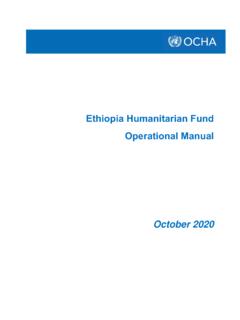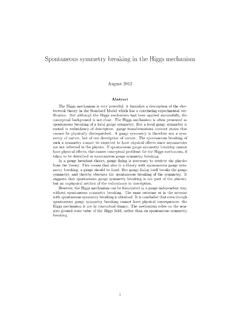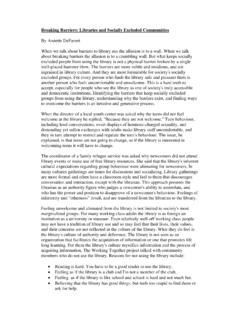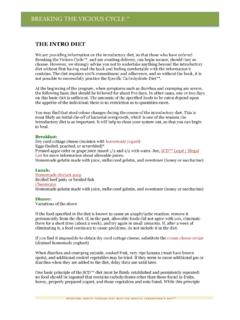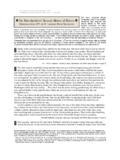Transcription of Breaking the impasse web - UNOCHA
1 IiACKNOWLEDGMENTSThis publication was developed by the Policy Advice and Planning Section of OCHA s Policy Development and Studies : Walter K lin and Hannah Entwisle and Layout: Karen Kelleher Carneiro, Javier Cueto and Paolo report benefited from the valuable contributions of the study s advisory group members: Mohammed Abdiker, Leah Tanodra-Armamento, Chaloka Beyani, Alexandra Bilak, Mark Bowden, Xavier Devictor, Paula Gaviria Betancur, Heidi Grau, Fabrizio Hochschild, Cecilia Jimenez-Damary, Andrew Kent, Pamela Komujuni Kalule, Izumi Nakamitsu, Robert Piper, Graham Saunders, Stephan Sch nemann, Balthasar Staehelin, and Volker T rk. Special thanks are due to the Chair of the advisory committee, Hansjoerg Strohmeyer, for his commitment and authors would also like to thank the many people who generously shared their experiences and expertise for this report through meetings, written feedback and workshops in the case-study countries (Colombia, Democratic Republic of Congo, Ukraine, the Philippines and Somalia).
2 In particular, special thanks are offered to Mark Bidder, Max Bonnel, Chiara Capozio, Mukrar Farah, Eden Garde, Gerard Gomez, Leo Kortekaas, Barbara Manzi, Rein Paulsen, and Akiko Yoshida for their contributions and support during the country visits. The authors would also like to thank the Joint IDP Profiling Service (JIPS) for contributing valuable data analysis from past profiling exercises in protracted internal displacement situations, and in particular Natalia Baal, Khadra Elmi, Laura Ronkainen, Eliana Rueda, Melissa Weihmayer, and Sam study was made possible through funding provided by Switzerland and the United , the authors greatly appreciate OCHA New York PDSB s careful review, comments and support for this report: Simon Bagshaw, Lilian Barajas, Aurelien Buffler, Lesley Bourns, Pia Hussein, Celine Monnier, Hannah Tonkin, Rodolpho Valente and Greta Zeender, as well as OCHA interns Zachary Barnett, Katherine Comly, Anna Jeffrey and Alex more information, please contact:Policy Development and Studies Branch (PDSB) United Nations Office for the Coordination of Humanitarian Affairs (OCHA) E-mail: 2017 United NationsISBN: 978-92-1-132046-6 eISBN.
3 978-92-1-060929-6i1TA B L E O F C O N T E N T SAcknowledgments iForeword 2 Executive summary 4 Introduction 10 I. Background 10 II. Purpose, Scope and Content 11 Part 1: Protracted internal displacement 15 I. The present situation 15 II. Conceptualizing Protracted Displacement 17 III. Addressing protracted displacement in different contexts and scenarios 21 IV. Protracted Displacement and Durable Solutions - A Complex Relationship 24 V. P r o t r a c t e d D i s p l a c e m e n t A C r o s s - C u t t i n g I s s u e 26 Part 2: Impacts of protracted internal displacement 30 I. Impacts on IDPs 30 II. Other Impacts 38 Part 3: Why internal displacement becomes protracted 44 I. Lack of safety and security 45 II. Political obstacles 45 III. Obstacles related to economic, social and cultural rights 46 IV. Obstacles related to civil and political rights 48 V. A i d d e p e n d e n c y a n d o t h e r s i d e e f f e c t s o f h u m a n i t a r i a n a c t i o n 49 VI.
4 Limited development, weak capacity of competent authorities, and lack of appropriate normative and institutional frameworks 50 VII. Lack of appropriate responses by international actors 51 VIII. Severe, sequential or repeated natural hazards 52 IX. Other reasons 52 Part 4: Collective outcomes: a new way to address protracted internal displacement 54 I. Notion 54 II. Background 55 III. Finding common understandings and forging partnerships 57 Part 5: Achieving collective outcomes to prevent and reduce protracted displacement 63 I. Overview: Elements necessary to achieve collective outcomes 63 II. Creating the evidence base 65 III. Defining collective outcomes 67 IV. Ensuring a strategic outlook by formulating a common problem statement: Shared context and risk analysis 71 V. I n t e g r a t i n g c o l l e c t i v e o u t c o m e s i n t o r e l e v a n t p l a n n i n g t o o l s 73 VI. Promoting and creating normative and institutional frameworks conducive to achieving collective outcomes 76 VII.
5 Prioritizing outcomeoriented programmes and projects 77 VIII. Securing transversal financing 80 Part 6: Conclusions and recommendations 83 I. Key findings 83 II. Key Recommendations 85 Annex I: Country case studies 92 I. Colombia 92 II. Democratic Republic of the Congo 96 III. Philippines 103 IV. Somalia 110 V. U k r a i n e 116 Annex II: Impacts on IDPs The Evidence 122 Annex III: Protracted Displacement in HRPs and UNDAFs 123 Acronyms and abbreviations 125 References 1262 FOREWORDA round the world, we are witnessing unprecedented numbers of people forced to flee their homes. Images of women, men and children displaced by conflict, violence and disasters have arrested our attention and demand action. While the international spotlight has increasingly focused on refugees and vulnerable migrants, the vast majority of displaced people find themselves within their countries, leaving them all too often invisible to the rest of the , there are more than 40 million internally displaced persons (IDPs) due to conflict and violence living in over 50 countries.
6 Millions more are displaced every year in the context of disasters and climate change. Lacking a home to return to and often fearful for their family s immediate safety, IDPs live with constant uncertainty about their well-being and future. Many seek shelter in extremely poor urban environments, where they rely on host families and communities for support. As IDPs remain displaced for months or years on end, host communities can become overwhelmed by the tremendous economic and social strain of supporting displaced people. For many, becoming displaced is a life-long sentence that profoundly affects IDPs, host communities, municipalities and countries as a nowhere else to turn, some IDPs grow dependent on humanitarian aid for survival. Humanitarian organizations work tirelessly to meet the immediate protection, health and other emergency needs of IDPs. But this enormous challenge cannot be solved by humanitarian action alone. This OCHA-commissioned study presents evidence that protracted internal displacement is primarily a development and political challenge with humanitarian elements.
7 Displacement-affected countries will not be able to achieve the Sustainable Development Goals including critical goals on poverty, education and gender equality without addressing protracted internal displacement. According to the authors, a new approach is needed to address both the short- and long-term needs of IDPs and host communities. Governments, development and humanitarian actors and donors must work together to achieve context-specific, clear and measurable collective outcomes that reduce vulnerabilities and support solutions to protracted internal displacement. The proposed approach echoes many of the key elements put forward in the New Way of Working, which calls for the pursuit of collective outcomes that reduce needs, risk and Agenda for Humanity, prepared in advance of the 2016 World Humanitarian Summit, challenged Member States, with the support of the international community, to reduce internal displacement by fifty percent by 2030 to ensure that millions of people are not left behind.
8 We now have an opportunity to realize this goal. Each of us has a role to play: Governments have the primary responsibility for protecting and addressing the needs of IDPs and creating conditions necessary to achieve durable 3solutions; international humanitarian and development organizations must work collaboratively to support Governments in addressing short- and long-term needs and reducing vulnerabilities; civil society and the private sector must become key allies in achieving collective outcomes; and IDPs and host communities must be integral partners throughout the process to prevent and reduce protracted , in different contexts, we see promising examples of how an approach based on collective outcomes can stimulate meaningful improvements for people living in protracted displacement. Colombia, a middle-income country, has set the ambitious goal of lifting 500,000 IDPs out of vulnerability by 2018 and discussions on how international development and humanitarian partners can best support this objective are already on-going.
9 In Somalia, while efforts to address most pressing humanitarian challenges continue, the first National Development Plan systematically integrates the needs of the displaced in its vision for the country s future, highlighting the link between protracted displacement, the reduction of vulnerabilities and long-term prosperity. We must build on these examples to transform our approach to protracted internal displacement and better support Government concerned to achieve the am grateful to Dr. Walter K lin and Ms. Hannah Entwisle Chapuisat for authoring this much-needed study. I also appreciate the dedication shown by members of the report s Advisory Group to share their insights and help carry the recommendations forward. The effort to provide hope to millions of people living in protracted internal displacement will require continued attention and investment at senior levels over a long period of time. As Emergency Relief Coordinator, I am deeply committed to help lead this effort.
10 I call on each of you to join me in taking strong and collective action for IDPs. Together, our work can ensure that millions of women, men and children around the world can lead rich and dignified O Brien Under-Secretary-General for Humanitarian Affairs and Emergency Relief Coordinator4 EXECUTIVE SUMMARYThe global number of internally displaced persons (IDPs) has reached an all-time high, as an increasing number of IDPs remain displaced for years or even decades. In 2014, more than 50 countries were reported to have people living in internal displacement for more than 10 years. As illustrated in the five country case studies informing this report (Colombia, the Democratic Republic of the Congo (DRC), the Philippines, Somalia and Ukraine)i, a rapidly resolved internal displacement crisis where IDPs find durable solutions sustainable return, local integration or relocation has become a rare of millions of IDPs are dependent on humanitarian assistance or live far below the poverty line in substandard housing without security of tenure, and with no or only limited access to basic services, education and health care.









